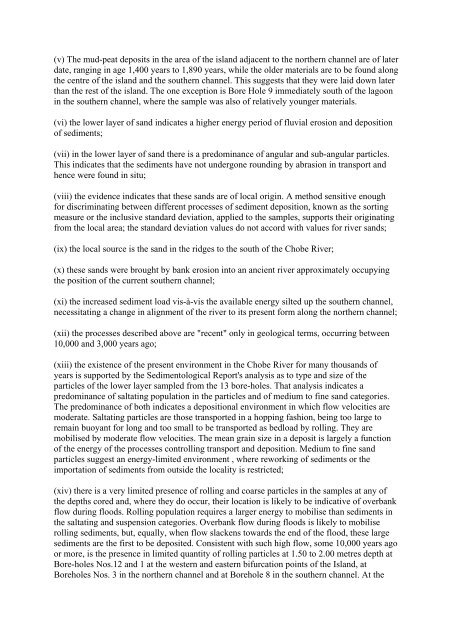botswana/namibia - Cour international de Justice
botswana/namibia - Cour international de Justice
botswana/namibia - Cour international de Justice
You also want an ePaper? Increase the reach of your titles
YUMPU automatically turns print PDFs into web optimized ePapers that Google loves.
(v) The mud-peat <strong>de</strong>posits in the area of the island adjacent to the northern channel are of later<br />
date, ranging in age 1,400 years to 1,890 years, while the ol<strong>de</strong>r materials are to be found along<br />
the centre of the island and the southern channel. This suggests that they were laid down later<br />
than the rest of the island. The one exception is Bore Hole 9 immediately south of the lagoon<br />
in the southern channel, where the sample was also of relatively younger materials.<br />
(vi) the lower layer of sand indicates a higher energy period of fluvial erosion and <strong>de</strong>position<br />
of sediments;<br />
(vii) in the lower layer of sand there is a predominance of angular and sub-angular particles.<br />
This indicates that the sediments have not un<strong>de</strong>rgone rounding by abrasion in transport and<br />
hence were found in situ;<br />
(viii) the evi<strong>de</strong>nce indicates that these sands are of local origin. A method sensitive enough<br />
for discriminating between different processes of sediment <strong>de</strong>position, known as the sorting<br />
measure or the inclusive standard <strong>de</strong>viation, applied to the samples, supports their originating<br />
from the local area; the standard <strong>de</strong>viation values do not accord with values for river sands;<br />
(ix) the local source is the sand in the ridges to the south of the Chobe River;<br />
(x) these sands were brought by bank erosion into an ancient river approximately occupying<br />
the position of the current southern channel;<br />
(xi) the increased sediment load vis-à-vis the available energy silted up the southern channel,<br />
necessitating a change in alignment of the river to its present form along the northern channel;<br />
(xii) the processes <strong>de</strong>scribed above are "recent" only in geological terms, occurring between<br />
10,000 and 3,000 years ago;<br />
(xiii) the existence of the present environment in the Chobe River for many thousands of<br />
years is supported by the Sedimentological Report's analysis as to type and size of the<br />
particles of the lower layer sampled from the 13 bore-holes. That analysis indicates a<br />
predominance of saltating population in the particles and of medium to fine sand categories.<br />
The predominance of both indicates a <strong>de</strong>positional environment in which flow velocities are<br />
mo<strong>de</strong>rate. Saltating particles are those transported in a hopping fashion, being too large to<br />
remain buoyant for long and too small to be transported as bedload by rolling. They are<br />
mobilised by mo<strong>de</strong>rate flow velocities. The mean grain size in a <strong>de</strong>posit is largely a function<br />
of the energy of the processes controlling transport and <strong>de</strong>position. Medium to fine sand<br />
particles suggest an energy-limited environment , where reworking of sediments or the<br />
importation of sediments from outsi<strong>de</strong> the locality is restricted;<br />
(xiv) there is a very limited presence of rolling and coarse particles in the samples at any of<br />
the <strong>de</strong>pths cored and, where they do occur, their location is likely to be indicative of overbank<br />
flow during floods. Rolling population requires a larger energy to mobilise than sediments in<br />
the saltating and suspension categories. Overbank flow during floods is likely to mobilise<br />
rolling sediments, but, equally, when flow slackens towards the end of the flood, these large<br />
sediments are the first to be <strong>de</strong>posited. Consistent with such high flow, some 10,000 years ago<br />
or more, is the presence in limited quantity of rolling particles at 1.50 to 2.00 metres <strong>de</strong>pth at<br />
Bore-holes Nos.12 and 1 at the western and eastern bifurcation points of the Island, at<br />
Boreholes Nos. 3 in the northern channel and at Borehole 8 in the southern channel. At the

















